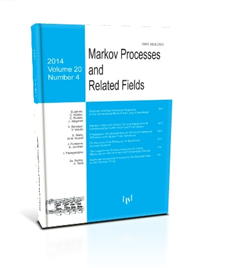Ancestral Problems in Population Genetics. A Short Introduction
T. Huillet
2009, v.15, Issue 3, 343-386
ABSTRACT
Forward evolution of large populations in genetics has a long history, starting in the 1920s; it is closely attached to the names of R.A. Fisher and S. Wright; see T. Nagylaki for historical commentaries and on the role played by the French geneticist G. Malecot, starting shortly before the second world war. The book of W. Ewens is an excellent modern presentation of the current mathematical theory. Coalescent theory is the corresponding backward problem, obtained while running the forward evolution processes backward-in-time. It was discovered independently by several researchers in the 1980s, but definitive formalization is commonly attributed to J. Kingman. It probably is a very important aspect of this growing field of interest. Major contributions to the development of coalescent theory were made (among others) by P. Donnelly, R. Griffiths, R. Hudson and S. Tavare (see the course of Tavare in Saint-Flour 2004 for a review). It included incorporating variations in population size, mutation, recombination, selection... In 1999, J. Pitman and S. Sagitov, independently, introduced coalescent processes with multiple collisions of ancestral lineages. Shortly later, the full class of exchangeable coalescent processes with simultaneous multiple mergers of ancestral lineages was discovered by M. Mohle and S. Sagitov and J. Schweinsberg. All these recent developments and improvements concern chiefly the discrete neutral case and their various scaling limits in continuous time and/or space. As was shown by Moehle, neutral forward and backward theories learn much from one another by using a concept of duality introduced by T. Liggett. Backward theory in the presence of mutations in the forward process is well-understood, as it requires the study of a marked Kingman's tree. In the works of C. Neuhauser and S. Krone, there is also some use of the duality concept in an attempt to understand the genealogies of a Wright - Fisher diffusion (as a limit of a discrete Wright - Fisher model) presenting a selection mechanism; this led these authors to the idea of the ancestral selection graph extending Kingman's coalescent tree of the neutral theory. There is therefore some evidence that the concept of duality could help one understand the backward theory even in non-neutral situations when various evolutionary forces are the causes of deviation to neutrality (see J. Crow and M. Kimura, T. Maruyama, J. Gillepsie and W. Ewens for a discussion on various models of utmost interest in population genetics). To fix the background, we shall briefly review both informally and incompletely some aspects of the formalism and problems arising in this context.
COMMENTS
Please log in or register to leave a comment

